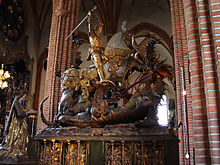Heinrich Wylsynck
Heinrich Wylsynck , also Wilsynck or Wilsing, first name also Hinrich or Henrick (* 3rd quarter of the 15th century, † 1533 in Lübeck ) was a painter and carver who worked in Lübeck.
Live and act
Wylsinck is considered the main assistant to his teacher Bernt Notke and was probably with him from 1483 to 1489 in his workshop in Stockholm , where, according to his own documented testimony, he worked on Sten Sture's commission for St. George with the dragon in the Nikolaikirche . Notke bequeathed him a mark in his will from 1501 . Wylsynck, in turn, rented Notke's house and workshop in Lübeck in 1506-08 and became one of his executors after his death in 1509 . Renting the workshop indicates that he was self-employed as a master in the same field. In the case of Wylsynck, the assignment of workpieces is unsecured and completely speculative. The dispute in art history is correspondingly divergent. Right from the start, the art historians tried to identify Wysynck's contributions to the action at St. George with the dragon in order to be able to draw conclusions about further works there from his formal language and working method:
- The Swedish art historian Johnny Roosval believed, based on his working hypothesis that Wylsynck was the creator of the base reliefs of George, to be able to assign the wood engravings of the first book of the incunable period , the Rudimentum novitorium , printed in 1475 by Lucas Brandis , to him, and the plates of Krispin in the St. Anne's monastery in Lübeck , panels on the altar in Tensta in the diocese of Uppsala (1489–90) and the paintings on the Schlutup altar in the St. Anne's Museum, as well as the woodcuts in the Revelationes Birgittae (1492) and others Lübeck incunabula.
- The German art historian Walter Paatz , on the other hand, saw the small reliefs on the castle and those on the armor of the knight Georg as the starting point for his then consequently different assignment. So Paatz came to the conclusion that Wylsynck must be identical to the emergency name named by the Swedish art historian Andreas Lindblom as the Imperialissima master . Whose work would at least fit better with the dates of Wylsynck's life.
literature
- Johnny Roosval: Hinrich Wylsynck, Ett bidrag till bokillustrationens historia i Lübeck mot slutet av 1400-talet. In: Nordisk tidskrift för bok- och biblioteksväsen. 23rd year, Almqvist & Wiksell, Uppsala / Stockholm 1936, pp. 181–189 ( runeberg.org ).
- Walter Paatz: Bernt Notke and his circle. Berlin 1939, p. 140 ff.
- Wylsynck, Heinrich . In: Hans Vollmer (Hrsg.): General lexicon of fine artists from antiquity to the present . Founded by Ulrich Thieme and Felix Becker . tape 36 : Wilhelmy-Zyzywi . EA Seemann, Leipzig 1947, p. 328 .
Individual evidence
- ↑ in memory of the battle on Brunkeberg
- ↑ J. Roosval: Hinrich Wylsynck,…. In: Nordisk tidskrift för bok- och biblioteksväsen. 23rd year, Almqvist & Wiksell, Uppsala / Stockholm 1936, p. 189 ( runeberg.org ).
- ^ Walter Paatz: Bernt Notke and his circle. Berlin 1939, pp. 140 ff, attributed the three aforementioned works to the master of the Reval Passion .
- ^ For example, the woodcuts by the B master of the Lübeck Bible from 1494, in Dat Bok in the Medelynghe Marie from 1494 and in the Lübeck Passionale from 1499.
| personal data | |
|---|---|
| SURNAME | Wylsynck, Heinrich |
| BRIEF DESCRIPTION | German painter and carver |
| DATE OF BIRTH | between 1450 and 1475 |
| DATE OF DEATH | 1533 |
| Place of death | Lübeck |
